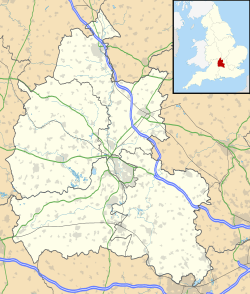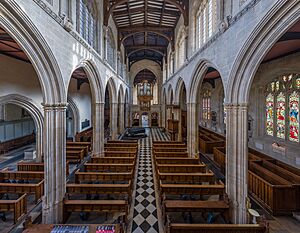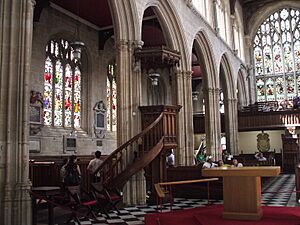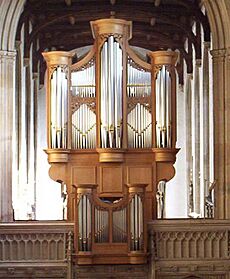University Church of St Mary the Virgin facts for kids
Quick facts for kids University Church of St Mary the Virgin |
|
|---|---|
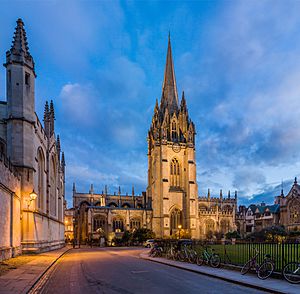
Church from Radcliffe Square
|
|
| 51°45′10″N 1°15′13.45″W / 51.75278°N 1.2537361°W | |
| Location | Oxford |
| Country | England |
| Denomination | Church of England |
| Churchmanship | High Church / Liberal Catholic |
| History | |
| Status | Parish church |
| Founded | About 1490 |
| Dedication | Blessed Virgin Mary |
| Consecrated | About 1500 |
| Events | Site of the 1555 trial of the Oxford Martyrs |
| Architecture | |
| Functional status | Active |
| Heritage designation | Grade I listed |
| Designated | 12 January 1954 |
| Style | English Gothic |
| Specifications | |
| Number of spires | 1 |
| Spire height | 191 feet (58 metres) |
| Administration | |
| Parish | Oxford |
| Diocese | Oxford |
| Province | Canterbury |
The University Church of St Mary the Virgin (often called St Mary's or SMV) is an Anglican church in Oxford, England. It stands on the north side of the High Street. This church is very important because the University of Oxford actually grew from it. Its local area (parish) is mostly made up of university and college buildings.
Contents
Exploring St Mary's Church
St Mary's has a unique porch facing High Street. This porch was designed by Nicholas Stone in a style called Baroque. Many church historians say its tall, pointed spire is one of the most beautiful in England. To the north of the church is Radcliffe Square, and to the east is Catte Street.
You can climb the 13th-century tower for a small fee. From the top, you get amazing views of historic Oxford. You can see Radcliffe Square, the famous Radcliffe Camera, Brasenose College, Oxford, and All Souls College.
A Look at History
A church has stood on this spot, right in the middle of the old walled city, since Anglo-Saxon times. Records from 1086 mention it.
The University's First Home
In the early days of Oxford University, St Mary's Church was the university's first main building. Students and teachers met there from at least 1252. By the early 13th century, it was where the university was run. It was also used for lectures and for giving out degrees.
Around 1320, a two-story building was added to the north side of the church. The bottom floor is now a café. The top floor held books given by Thomas Cobham, a bishop. This collection became the university's very first library!
Adam de Brome and Oriel College
In 1320, Adam de Brome became the church's rector (a type of priest). He later founded Oriel College in 1324. He used some of the church's income to help his new college. After this, Oriel College became responsible for choosing the vicar (another type of priest) and providing chaplains for the church.
The Oxford Martyrs
St Mary's was the place where the Oxford Martyrs were put on trial in 1555. These were three important religious leaders: Bishops Latimer and Ridley, and Archbishop Cranmer. They were tried for going against the official church beliefs of the time.
They were held in a nearby prison. Later, they were burned at the stake just outside the city walls. Today, a cross in Broad Street marks that spot. The nearby Martyrs' Memorial also remembers them.
On the morning of Cranmer's death in 1556, he was brought to the church. He stood on a small stage. From there, he famously took back his earlier statements against his Protestant beliefs. He declared that the hand which signed those statements would be the first to burn.
From Church to Theatre
Until the 1600s, the church was used for both prayers and university ceremonies. These ceremonies sometimes got very noisy! William Laud, the Archbishop of Canterbury, didn't like this. In the 1630s, he started building a separate place for these events.
This project stopped during the English Civil War. But after the war, John Fell continued the work. He hired Christopher Wren to build what is now the Sheldonian Theatre. After that, St Mary's Church was used only for religious services.
Famous Preachers
John Wesley, a very important religious leader, often attended sermons here. He even preached several times in the church. However, after one sermon in 1744 where he criticized some university members, he was never asked to preach there again.
In 1828, John Henry Newman became the vicar. His sermons became very popular with students. From the church's pulpit, John Keble gave a sermon in 1833. This sermon is seen as the start of the Oxford Movement. This movement aimed to bring back older, more traditional Christian practices to the Church of England. Newman later left St Mary's and joined the Roman Catholic Church.
Church Design and Features
The main part of the church was rebuilt in the late 1400s and early 1500s. This was done in the Perpendicular style. However, the oldest part of the church is the tower, which dates from around 1270. The beautiful Decorated spire was added in the 1320s. It has triple-gabled outer pinnacles, inner pinnacles, and statues.
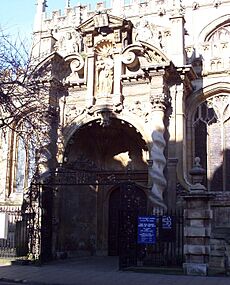
The south porch was built in 1637. It was designed by Nicholas Stone, who worked for King Charles I. This porch is very fancy, with spiral columns and a statue of the Virgin Mary and baby Jesus. Its style was too similar to Roman baroque for some people at the time. The porch was even used as evidence against Archbishop Laud during his trial. The bullet holes in the statue were made by Cromwellian soldiers.
Around 1328, a chapel was added by the rector, Adam de Brome. This is now the outer north aisle. The chancel (the area around the altar) was rebuilt around 1462. The nave (the main part of the church) and aisles were rebuilt around 1490. This was done with money from King Henry VII and several bishops.
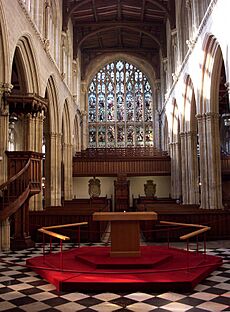
Inside, the church has tall arches with six sections. Between the upper windows are special niches with statues of angels. The roof has detailed patterns. The chancel has beautiful windows and a sedilia (seats for clergy). The reredos (a screen behind the altar) is from the 1400s. It holds seven statues added in 1933.
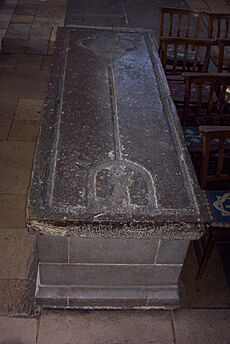
You can see several monuments inside. One is a stone slab believed to be for Adam de Brome from 1332. The church also has a modern floor slab for Amy Robsart, who was the wife of Robert Dudley.
The church was refitted in 1826–28 with new pews and galleries. The canopied pulpit, the font, and the chancellor's throne were designed by Thomas Plowman. The chancel has stalls from the late 1400s. The communion rail is from around 1675.
The tower is about 90 feet (27 meters) high. The spire on top is about 101 feet (31 meters) tall. This makes the total height of the church about 191 feet (58 meters).
Stained Glass Windows
Some parts of the 15th-century stained glass still remain in the east window. There are also 17th-century shields in the de Brome Chapel.
The east window and another in the south aisle were designed in the 1800s by Augustus Pugin. He was an English architect famous for his role in the Gothic Revival style. The west window in the nave was designed by C. E. Kempe in 1891.
The Organ
The church has a classical organ built by the Swiss company Metzler Orgelbau in 1986. This is one of only two organs by this famous maker in Great Britain. The other is in the chapel of Trinity College, Cambridge.
This organ was inspired by an older one built for the church in 1676 by "Father" Smith. The original organ was damaged by fire after the Second World War. The Metzler organ replaced a later organ. Its wooden case is based on Smith's original design. It even includes some carved wooden parts that survived the fire.
St Mary's Today
The current vicar of St Mary's is the Revd Canon William Lamb. Hannah Cartwright is the assistant priest. Robert Howarth is the director of music, and James Brown is the organist.
The church holds two Sunday services. During university terms, the church choir sings, and many well-known guest preachers give sermons.
The church is open to visitors almost every day of the year. It opens from 9:00 am to 5:00 pm (or 6:00 pm in July and August). On Sundays, the tower opens after the morning services. A German Lutheran service is also held once a month.
Images for kids
-
View north from St Mary's, looking into Radcliffe Square, with Brasenose College to the left (west), All Souls College to the right (east), the Bodleian Library, the Sheldonian Theatre and the Divinity School to the left of centre background, and the Radcliffe Camera centrally


